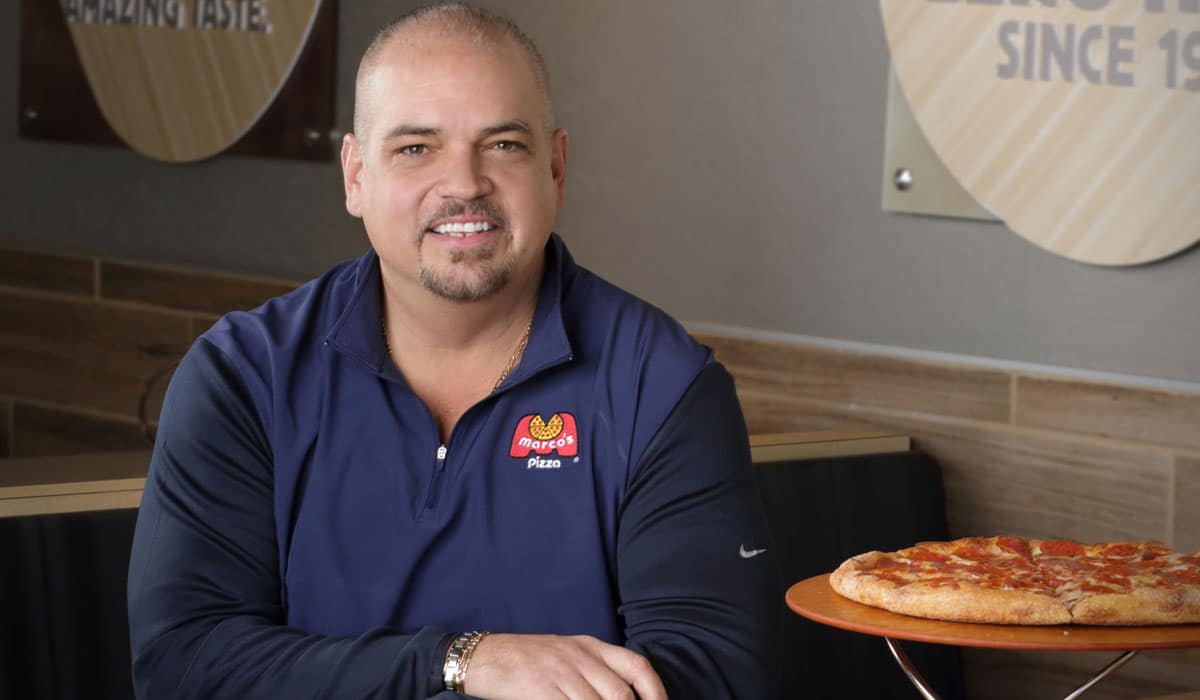Pizza has been uniquely bulletproof through the coronavirus pandemic. Papa John’s and Domino’s have boasted positive sales while committing to hiring thousands of new delivery drivers to handle the increased demand for a product that is both beloved comfort food and easy to serve contact-free.
Marco’s Pizza is no different. The sixth-largest pizza chain in the U.S., which did over $600 million in system-wide sales last year at more than 900 locations, has seen its year-over-year sales climb about 20 percent across the whole system, says president and COO Tony Libardi. In some markets, sales are up as much as 40 and even 50 percent.
For Libardi, it’s really no surprise. Not only do Americans eat an insane amount of pizza—he quotes one study that says 93 percent of Americans eat pizza at least once a month—but also, the pizza industry was way ahead of other restaurant companies in the off-premises game. Pizza chains have mastered delivery for the last 40 years, and most of them—Marco’s included—have very little dine-in space to begin with, so they didn’t lose much when state governments started mandating dining rooms to close back in March.
That’s afforded Marco’s the ability to not have to change up its operations drastically. Instead, it’s been able to focus its attention in the last couple of months on taking care of its people—both employees and guests—and spreading the message far and wide that Marco’s is a reliable and safe dining destination at this time of crisis.
“We immediately went out and started providing value, because we knew that was going to be essential,” Libardi says. “We started hammering that right away, telling folks, ‘We understand your fear and anxiety, and we’re going to do everything we can to mitigate those anxieties, to get what we perceive to be the best pizza in the industry to you fresh, hot, and safely, and that began to really resonate with consumers.”
Libardi says Marco’s owner-operators around the country have already been encouraged to support their communities, providing pizza for everything from schools and Parent Teacher Associations to local businesses, chambers of commerce, and fundraisers. That meant that when the crisis hit, Marco’s already had deeply planted roots to keep the business stable.
Despite Marco’s enjoying a banner sales year, Libardi says he’s not resting on his laurels. In fact, he’s so convinced that the COVID-19 pandemic will permanently change the face of the restaurant industry that he’s already exploring operational changes that can accommodate things like social distancing and contactless service.
“Restaurants are really going to have to be sensitive and understand that things like social distancing, which we never heard of prior to March of 2020, are going to be the new norm,” he says.
He lists several possible changes that are likely to become standard practice at restaurants across America, even after the coronavirus is behind us—things like smaller stores, dividers over the counters, masks on employees, maybe even hand-washing stations at the front counter.
“You remove all those touchpoints, all those contact points, which I think consumers are going to expect moving forward,” he says. “Simple things like doors—reaching out and grabbing a handle. Are automated doors in our future across every retail and restaurant establishment out there? All those points have to be considered and either removed and automated, or at least creating a perception of safety for the guests when they’re grabbing that door.”
Automation will be key to the restaurant industry of the future, Libardi says. That includes behind the counter; Marco’s employees are regularly in close quarters, shoulder to shoulder, making pizzas, he says, and some of their procedures will likely be automated if only to keep as few people in the kitchen as necessary.
“We have fortunately been testing an automated kitchen where machines are taking dough and saucing and cheesing them, and even a pepperoni slicer where it’s actually slicing and placing pepperoni on the pizza itself,” he says.
Libardi is even thinking about automated delivery. With third-party services like Grubhub and DoorDash struggling to make money—and restaurant operators increasingly frustrated by the rates those services charge—Libardi thinks robot delivery will be the natural next step to help control costs. Someday soon, he predicts, delivery aggregators will boast fleets of automated vehicles ready to deliver food to guests’ doors.
“[They] don’t look like cars, by the way; they’re just boxes on wheels that are going to show up at your door,” he says. “It’s going to let you know by phone that they’re there; you’re going to punch in a code and it’s going to open a door; you’re going to take whatever it was you ordered for delivery out, and you’re going to go in your house. You’re going to have very little interaction with people.”
Marco’s is here for all of it. Libardi is excited about the future of the restaurant industry, and is making sure his brand is as invested in modern innovation as tech-savvy startup concepts. In the last month, the company opened its first ghost-kitchen location in Los Angeles, a 250-square-foot facility in Hollywood with no storefront or signage, just a digital back-end that allows Marco’s to sling pizzas to millions more at a minimal investment.
Just like everything else related to off-premises, the new ghost kitchen seamlessly fits into Marco’s strategy of the past, present, and, most importantly, future.
“There’s a lot of work for the industry still to do to catch up to what pizza has been doing for decades,” he says. “We just have to continue to find ways to exploit what we do best and continue to innovate on what we do to outpace what the others will need to do to stay relevant.”
For more from Libardi about Marco’s strategy, stream the podcast above.








